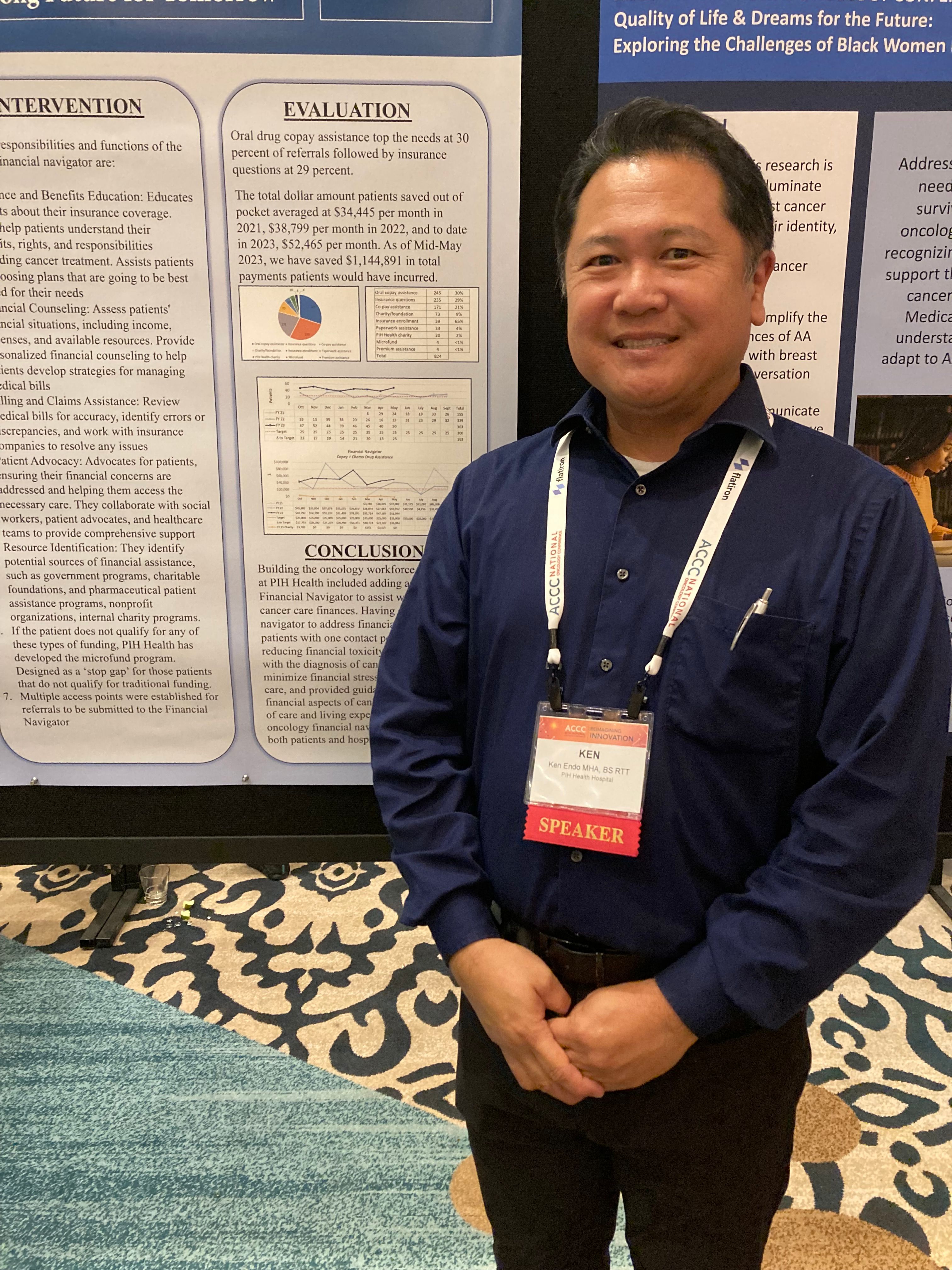News
Article
Oncology Financial Navigator Ensures Vital Care Access, Eases Economic Burden
Author(s):
According to the National Cancer Institute, in the year following a cancer diagnosis, the average cost of medical care plus medication exceeds $42,000, with some treatments having a price tag of more than $1 million.
Kenneth Endo, MHA, BS, RT(T) PIH Health Whittier Hospital

In the year following a cancer diagnosis, the average cost of medical care plus medication exceeds $42,000; some treatments even come in at an annual cost of more than $1 million.1 Initial care for brain cancer, for example, can top $139,000 and rise to $176,354 in the last year of life, while that for colorectal cancer is likely to exceed $66,000 and $110,000, respectively.2
Financial toxicity is a well-known and serious issue in the oncology space.
A poster presented at the Association of Community Cancer Centers 40th National Oncology Conference held October 4-6, 2023, in Austin, Texas, showed the results of PIH Health Whittier Hospital’s decision to incorporate an oncology financial navigator “to advocate and assist cancer patients and their families in managing the financial aspects of cancer care.”3
“As you know, financial toxicity is probably one of the worst things that our patients have to go through,” said author Kenneth Endo, MHA, BS, RTT, cancer program clinical director at Whittier, which is in California. “Some patients have to choose between putting food on the table or putting gas in the car vs treatment or spreading out their treatments.”
He added that the program was especially important at Whittier, because the hospital serves a socioeconomically diverse population—low-income areas bordered by more affluent communities—who otherwise might not have been able to afford treatment. The navigator has been able to not only help with copays, but find additional sources of patient assistance, such as charitable foundations and the hospital’s own microfund to provide something as small as a gas card to get the patient to their next treatment without excessive financial stress and ensure they are getting necessary care; the microfund is meant to serve as a stop gap for when patients do not qualify for traditional funding.
The oncology financial navigator was brought in following a community needs assessment that showed a top priority for many patients with cancer and the community is the cost of and paying for cancer care, and works with not only those groups, but health care providers and insurance companies “to identify and explore all available financial resources and options.”
Other top priorities when referred to the financial navigator included insurance enrollment (65%), oral copay assistance (30%), insurance questions (29%), copay assistance (21%), paperwork assistance (4%), and premium assistance (< 1%).
Primary responsibilities of the oncology financial navigator include the following:
- Insurance and benefits education: Patients get help understanding their benefits, rights, and responsibilities for treatment, as well as choosing the best plan that suits their health care needs
- Financial counseling: Patient income, expenses, and available resources are assessed, and they learn to develop strategies to manage bills
- Billing and claims assistance: This encompasses reviewing medical bills and working with insurance companies when issues arise, such as a billing discrepancy
- Patient advocacy: The navigator works with social workers, patient advocates, and health care teams to ensure financial concerns are addressed that might prevent them from receiving necessary care
- Resource identification: Potential sources of financial assistance are pinpointed, including government programs and pharmaceutical patient assistance programs
To date for 2023, the oncology financial navigator at PIH Health Whittier Hospital has saved patients a monthly average of $52,465 vs $38,799 in 2022 and $34,445 in 2021, or a 52% increase per patient per month in out-of-pocket savings.
Overall, the navigator has helped patients to save more than $1.1 million in total payments as of mid-May 2023.
“With cost of care and living expenses rising, having an oncology financial navigator is a benefit for both patients and the hospital,” Endo emphasized.
Potential areas of future investigation include evaluating additional data points and metrics, and pursuing potential opportunities to find and track patients whose first-choice treatment authorization was not approved but for whom a different treatment was approved that the physician doesn’t necessarily want to pursue.
“How do we get those funded if they choose to get treatment?” Endo posited. “I think where we’ll look at next is, how do we help those patients?”
References
1. Diagnosis: debt. NPR. July 9, 2022. Accessed October 13, 2023. https://tinyurl.com/6wueww4e
2. Financial burden of cancer care. National Cancer Institute. August 2023. Accessed October 13, 2023. https://progressreport.cancer.gov/after/economic_burden
3. Endo K. Financial navigation: assisting cancer patients today, building a strong future for tomorrow. Poster presented at: Association of Community Cancer Centers 40th National Oncology Conference; October 4-6, 2023; Austin, TX.

Impact of Telemedicine Use on Outpatient-Related CO2 Emissions: Estimate From a National Cohort

Impact of Telemedicine Use on Outpatient-Related CO2 Emissions: Estimate From a National Cohort
2 Commerce Drive
Suite 100
Cranbury, NJ 08512
© 2025 MJH Life Sciences® and AJMC®.
All rights reserved.



